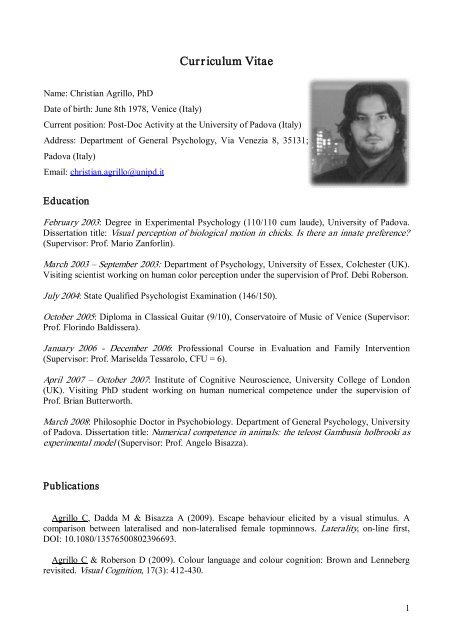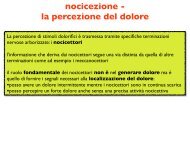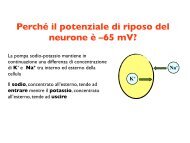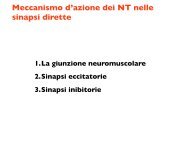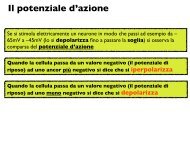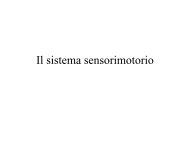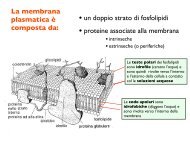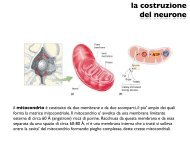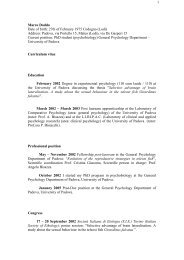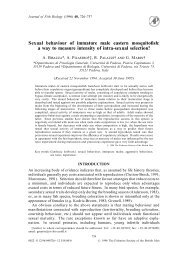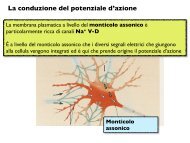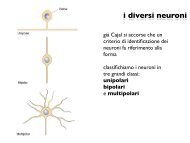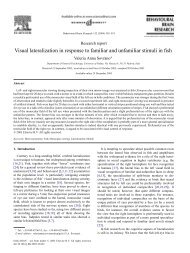Curriculum Vitae - CPRG
Curriculum Vitae - CPRG
Curriculum Vitae - CPRG
Create successful ePaper yourself
Turn your PDF publications into a flip-book with our unique Google optimized e-Paper software.
Name: Christian Agrillo, PhD<br />
Date of birth: June 8th 1978, Venice (Italy)<br />
Education<br />
<strong>Curriculum</strong> <strong>Vitae</strong><br />
Current position: PostDoc Activity at the University of Padova (Italy)<br />
Address: Department of General Psychology, Via Venezia 8, 35131;<br />
Padova (Italy)<br />
Email: christian.agrillo@unipd.it<br />
February 2003: Degree in Experimental Psychology (110/110 cum laude), University of Padova.<br />
Dissertation title: Visual perception of biological motion in chicks. Is there an innate preference?<br />
(Supervisor: Prof. Mario Zanforlin).<br />
March 2003 – September 2003: Department of Psychology, University of Essex, Colchester (UK).<br />
Visiting scientist working on human color perception under the supervision of Prof. Debi Roberson.<br />
July 2004: State Qualified Psychologist Examination (146/150).<br />
October 2005: Diploma in Classical Guitar (9/10), Conservatoire of Music of Venice (Supervisor:<br />
Prof. Florindo Baldissera).<br />
January 2006 December 2006: Professional Course in Evaluation and Family Intervention<br />
(Supervisor: Prof. Mariselda Tessarolo, CFU = 6).<br />
April 2007 – October 2007: Institute of Cognitive Neuroscience, University College of London<br />
(UK). Visiting PhD student working on human numerical competence under the supervision of<br />
Prof. Brian Butterworth.<br />
March 2008: Philosophie Doctor in Psychobiology. Department of General Psychology, University<br />
of Padova. Dissertation title: Numerical competence in animals: the teleost Gambusia holbrooki as<br />
experimental model (Supervisor: Prof. Angelo Bisazza).<br />
Publications<br />
Agrillo C, Dadda M & Bisazza A (2009). Escape behaviour elicited by a visual stimulus. A<br />
comparison between lateralised and nonlateralised female topminnows. Laterality, online first,<br />
DOI: 10.1080/13576500802396693.<br />
Agrillo C & Roberson D (2009). Colour language and colour cognition: Brown and Lenneberg<br />
revisited. Visual Cognition, 17(3): 412430.<br />
1
Pisa EP & Agrillo C (2009). Quantity discrimination in felines: a preliminary investigation of the<br />
domestic cat (Felis silvestris catus). Journal of Ethology, 27(2): 289293.<br />
Agrillo C, Dadda M, Serena G & Bisazza A (2009). Use of number by fish. PloS ONE, 4(3):<br />
e4786, doi:10.1371/journal.pone.0004786.<br />
Agrillo C & Nelini C (2008). Childfree by choice: a review. Journal of Cultural Geography,<br />
25(3): 347363.<br />
Agrillo C, Dadda M, Serena G & Bisazza A (2008). Do fish count? Spontaneous discrimination<br />
of quantity in female mosquitofish. Animal Cognition, 11(3): 495503.<br />
Agrillo C, Dadda M & Serena G (2008). Choice of female groups by male mosquitofish<br />
(Gambusia holbrooki). Ethology, 114(5): 479488.<br />
Agrillo C (2008). L’evoluzione cerebrale degli ominidi: quando antropologia, paleontologia e<br />
psicologia convergono su una domanda. Antrocom: Online Journal of Anthropology, 4(1): 5158.<br />
Agrillo C & Dadda M (2007). Discrimination of the larger shoal in the poeciliid fish Girardinus<br />
falcatus. Ethology, Ecology & Evolution, 19(2): 145157.<br />
Agrillo C & Nelini C (2007). Figli di una società senza tempo: una lettura sociobiologica del<br />
fenomeno childfree. Rivista di Studi Familiari: Famiglia, Interdisciplinarità, Ricerca, 12(1): 124<br />
136.<br />
Agrillo C, Dadda M & Bisazza A (2007). Quantity discrimination in female mosquitofish.<br />
Animal Cognition, 10: 6370.<br />
Agrillo C, Dadda M & Bisazza A (2006). Sexual harassment influences group choice in female<br />
mosquitofish. Ethology, 112: 592598.<br />
Peer reviewed shor t publications or proceedings<br />
Agrillo C, Dadda M, Serena G, Piffer L & Bisazza A (2009). Fish can use numerical information<br />
when discriminating between small discrete quantities. Proceeding of the 31st Annual Meeting of<br />
the Cognitive Science Society (COGSCI 2009), Amsterdam (Netherland), In press.<br />
Agrillo C & Chiandetti C (2009). Why do musicians choke under pressure? State of the art. In:<br />
Roth, R., Hiew, C. & Comunian A.L. (Eds.). Peace, Hope and WellBeing across the Cultures.<br />
Shaker Verlag, Aachen, 156165.<br />
Agrillo C, Serena G & Dadda M (2009). Numbers without language: the contribution of cultural,<br />
developmental and comparative psychology. In: Roth, R., Hiew, C. & Comunian A.L. (Eds.).<br />
Peace, Hope and WellBeing across the Cultures. Shaker Verlag, Aachen, 202212.<br />
Agrillo C, Ranpura A & Butterworth B (2008). Time and numerosity estimation are independent:<br />
behavioural evidence on two different systems using a conflict paradigm. Proceedings of the 6th<br />
International Conference on Thinking, San Servolo, Venice (Italy), pp. 118.<br />
2
Agrillo C & Roberson D (2007). Colour memory and communication in English speakers: Are<br />
focal colours easier to name and remember? In: Comunian A. L. & Roth R. (EDS): International<br />
Perspectives in Psychology, Shaker Verlag Publishing, Aachen, 7988.<br />
Agrillo C, Dadda M, Serena G & Bisazza A (2007). Do the math: roots of numerical competence<br />
in fish. Neural Plasticity, 2007: 4748, doi:10.1155/2007/23250.<br />
Roberson D & Agrillo C (2005). Color language and color cognition: Brown and Lenneberg<br />
Revisited. Proceeding of the 27th Annual Meeting of the Cognitive Science Society (COGSCI<br />
2005). Stresa, Italy: pp. 18681871.<br />
Agrillo C, Regolin L & Vallortigara G (2004). Can young chicks take into account the observer’s<br />
perspective? Perception, 33 (supplement): 110111.<br />
Clara E, Agrillo C, Regolin L & Vallortigara G (2003). “Spontaneous preference for symmetrical<br />
stimuli in visually naive chicks”. In: Birgitta Berglund (Ed.), Fechner Day 2003: Proceedings of the<br />
19th Annual Meeting of the International Society for Psychophysics. Cyprus, Greece: International<br />
Society for Psychophysics, pp. 4752.<br />
Popular Publications (Italian)<br />
Agrillo C (2009). Numeri da pesce. www.acquariofiliaitalia.it, Newsletter Aprile 2009.<br />
Agrillo C (2008). Neuroni e musica: chi dirige l’orchestra? Scienza e Conoscenza, 53: 1417.<br />
Dadda M & Agrillo C (2008). Le capacità matematiche dei pesci. www.acquariofiliaitalia.it,<br />
Newsletter Ottobre 2008.<br />
Agrillo C (2008). La lateralizzazione cerebrale nel pecilide Girardinus falcatus.<br />
www.acquariofiliaitalia.it, Newsletter Marzo 2008.<br />
Agrillo C (2007). Perchè i musicisti sbagliano in pubblico? Quando la scienza sale sul<br />
palcoscenico. Guitart, 47: 3133.<br />
Agrillo C (2007). Perchè i musicisti sbagliano in pubblico? La parola ai concertisti. Guitart, 48:<br />
2124.<br />
Agrillo C (2007). La scienza degli errori. Perchè i concertisti sbagliano in pubblico. Musica, 189:<br />
4547.<br />
Agrillo C (2007). Un po’ meno attenzione per suonare meglio: la ricerca scientifica sulla<br />
psicologia del concertismo. Il Giornale della Musica, 241: 45.<br />
Agrillo C (2007). Nella mente del concertista. Psicolab, Ottobre: 6770.<br />
Agrillo C (2007). La paura del pubblico tra i musicisti. Psicolab, Ottobre: 7176.<br />
Agrillo C (2007). Psicologi e musicisti: due facce, due razze? Psicolab, Ottobre: 7778.<br />
3
Books<br />
Agrillo C (2007). Suonare in pubblico. L’esperienza concertistica e i processi neurocognitivi.<br />
Carocci editore, Roma.<br />
Conferences<br />
Oral presentation:<br />
December 2002: “The X Kanizsa Lecture”, Trieste (Italy). “Visual perception of biological<br />
motion. Is there an innate preference? " Authors: Regolin L, Marconato F, Agrillo C & Vallortigara<br />
G.<br />
November 2005: “The XIII Kanizsa Lecture”, Trieste (Italy). “Numerousness discrimination in<br />
fish: a preliminary investigation in female mosquitofish”. Authors: Agrillo C, Dadda M & Bisazza<br />
A.<br />
December 2005: “Second European Conference of Poeciliid Biologists”, Trondheim (Norway).<br />
“Discrimination of relative numerosity in fish: a preliminary investigation in Gambusia holbrooki”.<br />
Authors: Agrillo C, Dadda M & Bisazza A.<br />
March 2006: “Association for the Study of Animal Behaviour meeting (ASAB)”, Nottingham<br />
(UK). “Numerical competence in fish”. Authors: Agrillo C, Dadda M & Bisazza A.<br />
September 2006: “Convegno nazionale della società italiana di etologia (SIE)”, Erice (Italy).<br />
“Discriminazione di quantità nei pesci”. Authors: Agrillo C, Dadda M & Bisazza A.<br />
January 2007: “Convegno nazionale di studi sulla famiglia: Childfree, liberi da… liberi<br />
per…”, Padova (Italy).“Childfree: figli di una società senza tempo”. Authors:Agrillo C & Nelini C.<br />
February 2007: “Ethological Society Conference: Social Organization and Cognitive Tools.<br />
General Patterns in Vertebrates?”, Grünau (Austria). “Quantity discrimination in fish”. Authors:<br />
Agrillo C, Dadda M & Bisazza A.<br />
March 2008: “Third European Conference of Poeciliid Biologists”, Chioggia (Italy). “Do<br />
mosquitofish show any evidence of being able to count?”. Authors: Agrillo C, Dadda M, Serena G<br />
& Bisazza A.<br />
March 2008: “Third European Conference of Poeciliid Biologists”, Chioggia (Italy).<br />
“Ecological costs of cerebral lateralization”. Authors: Dadda M, Agrillo C, Zandonà E. & Bisazza<br />
A.<br />
September 2008: “Convegno nazionale della società italiana di etologia (SIE)”, Arcavacata di<br />
Rende (Italy). “Numerosità come ultima risorsa? Meccanismi utili zati dal teleosteo Gambusia<br />
hobrooki nella distinzione tra due quantità”. Authors: Agrillo C, Dadda M, Serena G, Bonaldo B &<br />
Bisazza A.<br />
4
September 2008: “Convegno nazionale della società italiana di etologia (SIE)”, Arcavacata di<br />
Rende (Italy). “Costi della laterali zazione cerebrale nel teleosteo Girardinus falcatus”. Authors:<br />
Dadda M, Agrillo C, Zandonà E, & Bisazza A.<br />
October 2008: “The XVI Kanizsa Lecture”, Trieste (Italy). “Fish math: do mosquitofish use<br />
numbers as ‘last resort’ when choosing between two quantities?”. Authors: Agrillo C, Dadda M,<br />
Serena G & Bisazza A.<br />
March 2009: “Association for the Study of Animal Behaviour meeting (ASAB)”, Cardiff<br />
(UK). “Ontogeny of numerical competence in guppies”. Authors: Agrillo C, Serena G, Piffer L &<br />
Bisazza A (1 st prize for the best talk presentation).<br />
Poster presentation:<br />
October 2003: “Fechner Day 2003”, Larnaca Bay (Cyprus). “Spontaneous preference for<br />
symmetrical stimuli in visually naive chicks”. Authors: Clara E, Agrillo C, Regolin L & Vallortigara<br />
G.<br />
April 2004: “Association for the Study of Animal Behaviour meeting (ASAB)”, Brighton<br />
(England). “Are chicks sensitive to what the observer can or cannot actually see?”. Authors: Agrillo<br />
C, Regolin L & Vallortigara G.<br />
August 2004: “27th Annual Meeting of the European Conference on Visual Perception<br />
(ECVP)”, Budapest (Hungary). “Can young chicks take into account the observer’s perspective?”.<br />
Authors: Agrillo C, Regolin L & Vallortigara G.<br />
September 2004: “Convegno nazionale della società italiana di etologia (SIE)”, Padova (Italy).<br />
“Chicks’ sensitivity to the visual information accessible to an artificial observer”. Authors: Agrillo<br />
C, Regolin L & Vallortigara G.<br />
September 2004: “Convegno nazionale della società italiana di etologia (SIE)”, Padova (Italy).<br />
“Discriminazione numerica in Gambusia holbrooki”. Authors: Agrillo C, Dadda M & Bisazza A.<br />
December 2004: “The Twelfth Kanizsa Lecture”, Trieste (Italy). “Are chicks sensitive to what<br />
the observer can or cannot actually see?”. Authors: Agrillo C, Regolin L & Vallortigara G.<br />
July 2005: “XXVII Annual Conference of the Cognitive Science Society (CogSci2005)”,<br />
Stresa (Italy). “Color language and color cognition: Brown and Lenneberg revisited”. Authors:<br />
Roberson D & Agrillo C.<br />
December 2005: “Second European Conference of Poeciliid Biologists”, Trondheim (Norway).<br />
“Male sexual harassment influences shoaling preferences in female mosquitofish”. Authors: Agrillo<br />
C, Dadda M & Bisazza A.<br />
July 2006: “5 Th Forum of European Neuroscience (FENS)”, Vienna (Austria). “Discrimination<br />
of relative numerosity in fish”. Authors: Agrillo C, Dadda M & Bisazza A.<br />
5
July 2006: “The 64 th International Council of Psychologists Conference”, Kos (Greece).<br />
“Language and cognition in colours: Brown and Lenneberg revisited”. Authors: Roberson D &<br />
Agrillo C. (1 st prize for the Overall Poster Presentation).<br />
September 2006: “Congresso nazionale dell’associazione italiana di psicologia (AIP),<br />
Rovereto (Italy). “Discriminazione spontanea di numerosità relative nei pesci”. Authors: Agrillo C,<br />
Dadda M & Bisazza A.<br />
October 2006: “The Fourteenth Kanizsa Lecture”, Trieste (Italy). “The role of perceptual<br />
features in the quantity discrimination in fish (Gambusia holbrooki)”. Authors: Agrillo C, Dadda<br />
M, Serena G & Bisazza A.<br />
October 2006: “The Fourteenth Kanizsa Lecture”, Trieste (Italy). “Colour language and<br />
colour cognition: easy to name, easy to remember and communicate?”. Authors: Roberson D &<br />
Agrillo C.<br />
August 2007: “The 65 th International Council of Psychologists Conference”, San Diego<br />
(USA). “Psychology of musicians: why do pianist performances degrade under pressure?”.<br />
Authors: Agrillo C & Chiandetti C.<br />
August 2007: “The 65 th International Council of Psychologists Conference”, San Diego<br />
(USA). “Numbers without language: what cultural, developmental and comparative psychology<br />
can teach us about the sense of number shared by humans and animals?”. Authors: Serena G,<br />
Agrillo C & Dadda M.<br />
August 2007: “The 65 th International Council of Psychologists Conference”, San Diego<br />
(USA). “Childfree by choice: a sociobiological interpretation of the phenomenon”. Authors:<br />
Agrillo C & Nelini C.<br />
September 2007: “The 39 th European Brain and Behaviour Society Meeting (EBBS)”, Trieste<br />
(Italy). “Do the math: roots of numerical competence in fish”. Authors: Agrillo C, Dadda M, Serena<br />
G & Bisazza A.<br />
January 2008: “XXVI European Workshop on Cognitive Neuroscience”, Bressanone (Italy).<br />
“Do fish count? Spontaneous discrimination of quantity in female mosquitofish”. Authors: Agrillo<br />
C, Dadda M, Serena G & Bisazza A.<br />
March 2008: “Third European Conference of Poeciliid Biologists”, Chioggia (Italy). “Male<br />
preference for female groups in Gambusia holbrooki”. Authors: Serena G, Agrillo C & Dadda M.<br />
July 2008: “The 66 th International Council of Psychologists Conference”, St. Petersburg<br />
(Russia). “Depression among cultures”. Authors: Agrillo D & Agrillo C.<br />
August 2008: “Sixth International Conference on Thinking”, Venice (Italy). “Time and<br />
numerosity estimation are independent: behavioural evidence on two different systems using a<br />
conflict paradigm”. Authors: Agrillo C, Ranpura A & Butterworth B.<br />
September 2008: Congresso nazionale dell’associazione italiana di psicologia (AIP), Padova<br />
(Italy). “Ontogenesi dei giudizi di quantità nei pesci”. Authors: Serena G, Agrillo C, Vinco E &<br />
Bisazza A.<br />
6
September 2008: “Convegno nazionale della società italiana di etologia (SIE)”, Arcavacata di<br />
Rende (Italy). “Ontogenesi della discriminazione numerica in Poecilia reticulata”. Authors: Agrillo<br />
C, Serena G & Bisazza A.<br />
September 2008: “Convegno nazionale della società italiana di etologia (SIE)”, Arcavacata di<br />
Rende (Italy). “Laterali zazione cerebrale e comportamento di fuga nel teleosteo Girardinus<br />
falcatus”. Authors: Dadda M, Agrillo C & Bisazza A.<br />
January 2009: “XXVII European Workshop on Cognitive Neuroscience”, Bressanone (Italy).<br />
“Ontogeny of numerical skills in fish suggests separate systems for small and large numbers'<br />
discrimination”. Authors: Piffer L, Serena G, Agrillo C, Bisazza A.<br />
January 2009: “XXVII European Workshop on Cognitive Neuroscience”, Bressanone (Italy).<br />
“Time and numerical estimation do not share a single accumulator: evidence on two independent<br />
systems using a conflict paradigm”. Authors: Agrillo C, Ranpura A & Butterworth B.<br />
Participation to other conferences:<br />
May 2003: “Research Seminar Weekend”, Cumberland Lodge, Windsor (England).<br />
January 2006: “XXIV European Workshop on Cognitive Neuroscience”, Bressanone (Italy).<br />
September 2006: “The Second World Conference: The Future of Science. Evolution of mind”<br />
Venice (Italy).<br />
January 2007: “XXV European Workshop on Cognitive Neuroscience”, Bressanone (Italy).<br />
Main invited seminars<br />
March 2007: “Unità di Primatologia Cognitiva, CNR”, Roma (Italy). Seminar entitled: “Lo<br />
studio delle competenze numeriche nei pesci”.<br />
April 2007: “Institute of Cognitive Neuroscience, University College of London” (UK).<br />
Seminar entitled: “Quantity discrimination in fish”.<br />
May 2007: “Zoological Institute, University of Bern” Bern (Switzerland). Seminar entitled:<br />
“Numerical Competence in fish”.<br />
February 2008: “Neuroscience Cafè”, Trieste (Italy). Seminar entitled: “Why do musician choke<br />
under pressure?”<br />
June 2008: “Udin&Jazz 2008”, Libreria Feltrinelli, Udine (Italy). Seminar entitled: “Nella testa<br />
del ja zista, uno studio/esperimento sul cervello di chi impro visa ”.<br />
7
Ad Hoc Referee:<br />
Ethology;<br />
Animal Cognition;<br />
Behavioural Processes;<br />
International Perspectives in Psychology. Shaker Verlag Publishing, Aachen.<br />
Proceedings of the Annual Meeting of Cognitive Science Society (COGSCI 2009).<br />
Awar ds<br />
Academic Year 20022003: Winner of ErasmusSocrates project funding for six month postgraduate<br />
activity at the University of Essex (Colchester, UK).<br />
August 2006: 1 st prize for the overall poster presentation at the 64 th The International Council of<br />
Psychologists Conference, Kos (Greece).<br />
April 2008 – June 2009: Research Grant (3360 £) of the Association for the Study of Animal<br />
Behaviour.<br />
April 2009: 1 st prize for best talk at the Association for the Study of Animal Behaviour (Easter<br />
meeting), Cardiff (UK).<br />
Professional societies:<br />
January 2006 – present: Member of the Association for the Study of the Animal Behaviour<br />
(ASAB).<br />
October 2006 – present: Member of the Association of the Italian Society of Ethology (SIE).<br />
January 2007 – January 2008: Member of the European Brain and Behaviour Society (EBBS).<br />
May 2007 – October 2007: Honorary Research Assistent of the Institute of Cognitive Neuroscience<br />
(ICN), University College of London (UK).<br />
March 2008 – present: Member of the ‘Associazione Italiana di Psicologia’ (AIP).<br />
June 2008 – present: Member of the Association for Psychological Science (APS).<br />
Main press interviews, articles and br oadcasts on my research:<br />
National Geographic (31/03/09): “Fish Can Count, Study Finds”, by Christine Dell’Amore.<br />
New Scientist (by Ewen Callaway)<br />
BBC natural history online “www.lovehearth.com”(25/02/08): “Fish can count” by Matt Walker.<br />
BBC Radio Scotland (by Jennifer Westbrook)<br />
Rai TG1 (Italian news, by Giovanni Masotti)<br />
The Daily Telegraph (26/02/08): “Fish can count to four but not higher”, by Charles Clover<br />
8
The Guardian (26/02/08): “Researchers find fish that can count up to four”, by James Randerson<br />
Daily Mail (26/02/08): “Fish fingers: the goldfish that can count to four”.<br />
CBC (Canadian Radio)<br />
Nova Tv (Czech news, by Adam Halmosi)<br />
Thaindian News (27/02/08): “Fish can count but only up to four”<br />
Mediehuset Nettavisen (04/04/2009): “Se, fisken teller!”, by Niklas Tessem.<br />
Il Corriere della Sera (01/03/08): “Quanto fa 1+1? Il gatto sa rispondere”, by Danilo Mainardi.<br />
Il Giornale (27/2/08): “I pesci sanno contare”, by Nino Materi.<br />
Il Mattino di Padova (27/02/08): “I pesci sanno contare. Fino a quattro”<br />
Il Gazzettino (27/20/08): “Anche i pesci sanno contare: almeno fino a quattro”, by Federica<br />
Cappellato.<br />
Triveneta (Italian TV channel)<br />
Italian Innovation (03/03/08): “Sorpresa: anche i pesci sanno contare”, by Federico Maselli.<br />
Il giornale di Vicenza (28/02/08): “I pesci sanno contare fino a quattro”.<br />
Il Venezia (Italian newspaper)<br />
Radio BCS (Italian Radio)<br />
Radio Due (Italian Radio)<br />
Other pr ofessional activities:<br />
September 2004 June 2005: Department of General Psychology, University of Padova.<br />
Tutorship activities of the Faculty of Psychology.<br />
January December 2006: Research students representative of the PhD school in Psychobiology,<br />
University of Padova.<br />
January 2007 – August 2007: Member of the 2007 InAbsentia Poster Project Committee for<br />
proposals to the 65 th International Council of Psychologists’ Meeting (San Diego, USA).<br />
November 2007 March 2008: Organizer member of the Third European Conference of Poeciliid<br />
Biologists (Chioggia, Italy).<br />
9


